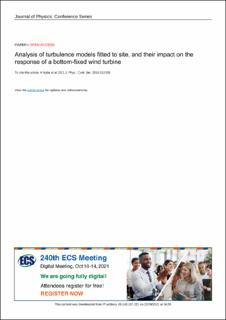Analysis of turbulence models fitted to site, and their impact on the response of a bottom-fixed wind turbine
Journal article, Peer reviewed
Published version

Åpne
Permanent lenke
https://hdl.handle.net/11250/2986674Utgivelsesdato
2021Metadata
Vis full innførselSamlinger
- Geophysical Institute [1198]
- Registrations from Cristin [9791]
Originalversjon
Journal of Physics: Conference Series. 2021, 2018, 012028. 10.1088/1742-6596/2018/1/012028Sammendrag
This study compares a wind field recommended by the wind turbine design standards to more realistic wind fields based on measurements. The widely used Mann spectral tensor model with inputs recommended by the standard, is compared to FitMann, the Mann model with inputs fitted to measurements and TIMESR; using measured time series combined with the Davenport coherence model. The Mann model produces too low energy levels at the lowest frequencies of the wind spectra, while the wind spectra generated by FitMann approaches the measured values. TIMESR reproduces the measured spectral values at all frequencies. The different models give similar vertical coherence, while the Mann and FitMann models give lower horizontal coherence than TIMESR. Investigating the wind loads on a bottom-fixed 10-MW wind turbine, the spectra for the tower bottom fore-aft and blade root flapwise bending moment follow the shape of the wind spectra closely at low frequencies. The low-frequency range is important for the blade root and in particular the tower bottom bending moment. Thus, the TIMESR model, followed by FitMann, is assumed to give the most accurate fatigue estimates. For the specific situation analysed in this study, the FitMann model gives only 18 and 5 % lower estimates than TIMESR of the tower bottom and blade root damage equivalent bending moments, while the Mann model gives 27 % and 12 % lower estimates. The tower top yaw and fore-aft bending moments depend on the wind coherence. For the specific situation analysed in this study, the FitMann model gives 9 and 5 % higher estimates of the tower top yaw and tower top damage equivalent (bending) moments compared to TIMESR, while the Mann model gives 23 % and 18 % higher estimates. Since only measurements of the vertical coherence are available, it is not clear which model is superior for the tower top moments. However, the importance of a proper coherence model is documented.
